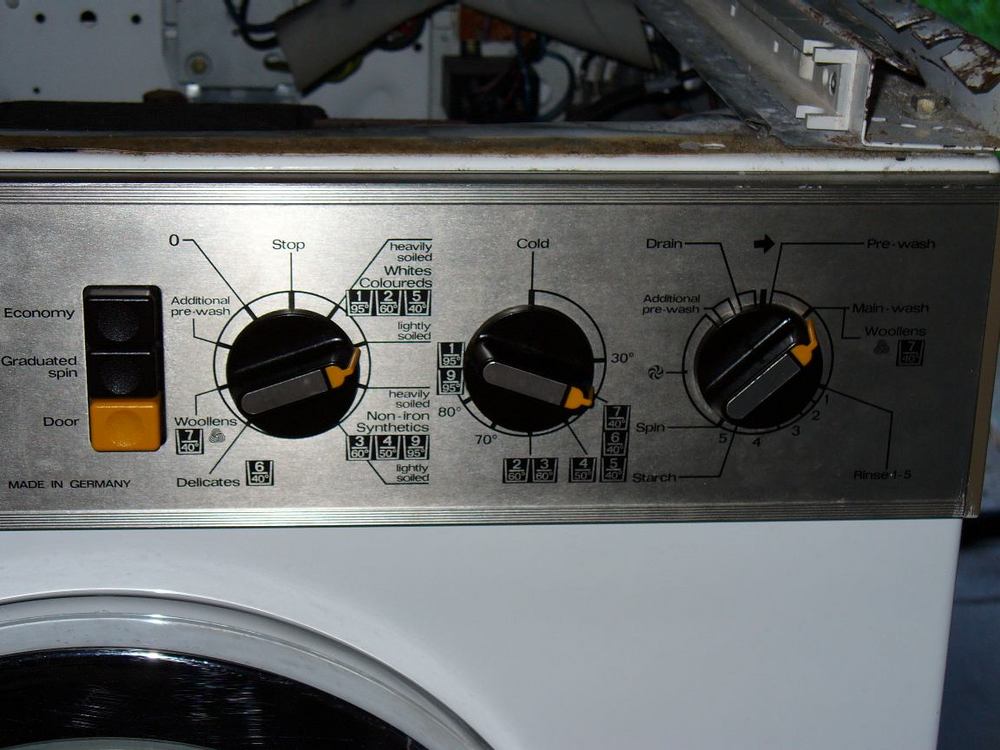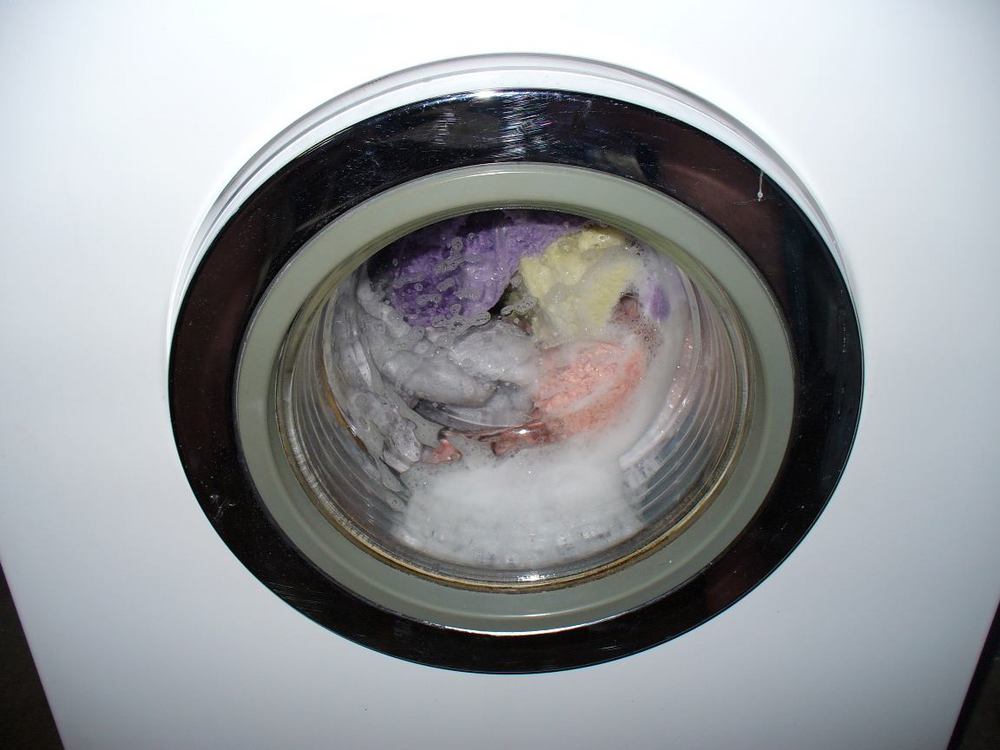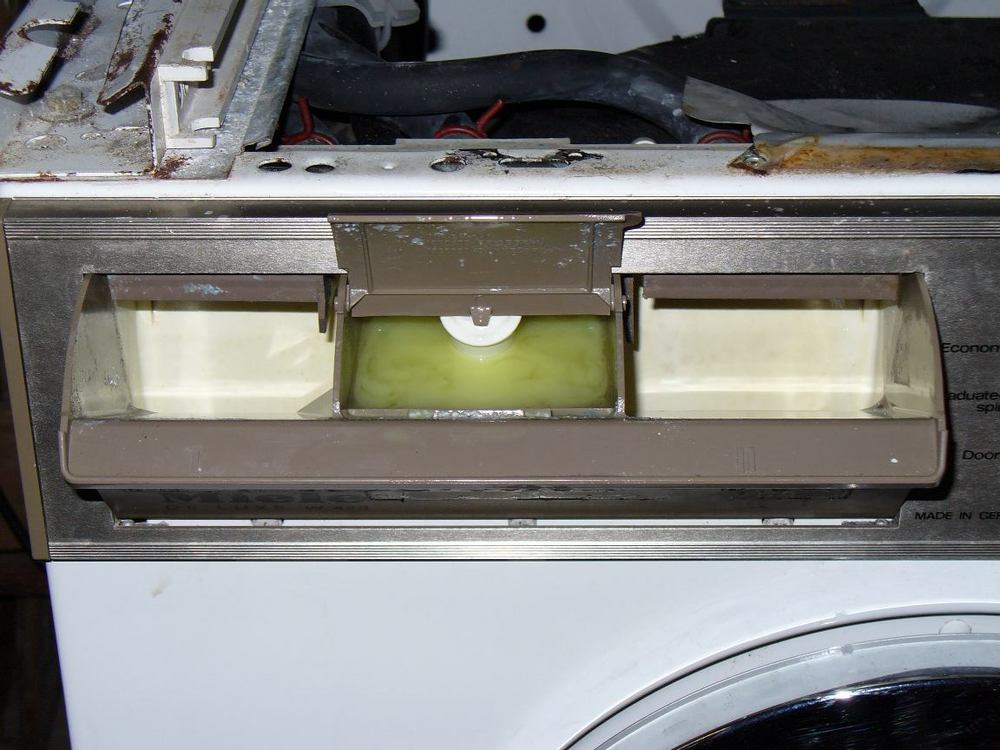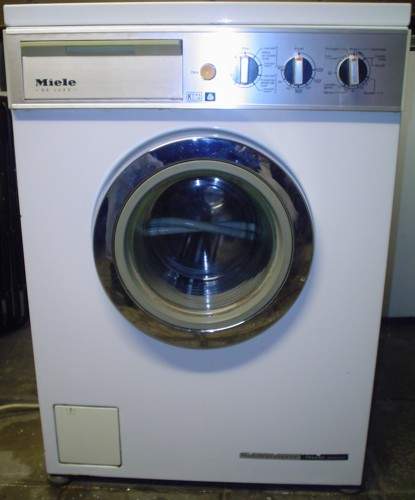|
Thread Number: 4491
Miele Washer & Dryer |
[Down to Last] |

|
| Post# 101875 , Reply# 1 1/5/2006 at 17:54 (6,683 days old) by shanonabc () | ||
|
whoa, lucky! | ||
| Post# 101903 , Reply# 4 1/5/2006 at 19:49 (6,682 days old) by lavamat_jon (UK) | ||
|
Woop :-D. Can't wait! Is this one of the 900 or 1100rpm machines? Jon :-) | ||
| Post# 101904 , Reply# 5 1/5/2006 at 19:50 (6,682 days old) by lavamat_jon (UK) | ||
|
My mistake... Saw that you typed it was an 1100 spin machine. Old age is setting in... :-) | ||
Post# 101905 , Reply# 6 1/5/2006 at 19:50 (6,682 days old) by brisnat81  (Brisbane Australia) (Brisbane Australia) |
||
|
According to the brochure, they're all 1100RPM machines. The speed seems to be set with the cycle. | ||
Post# 102009 , Reply# 8 1/6/2006 at 10:36 (6,682 days old) by foraloysius  (Leeuwarden, Friesland, the Netherlands) (Leeuwarden, Friesland, the Netherlands) |
||

Tom, The older Mieles have five rinses and they spin after the third, the fourth and (ofcourse) after the last rinse. The speed on the short spins after the third and fourth rinse is 800rpm. This was how a lot of the European frontloaders of that time worked albeit some had a lower speed. I guess fear of a sudslock could be the reason. I think the older Mieles do quite a good job at rinsing. Ofcourse a spin direct after the main wash and after all the rinses are more effective. Nathan, I love that washer. What model number is it? Is it a W423 or W431? Or even another number? Inquiring minds want to know. If this machines spins with 1100rpm then it must be one of the first Mieles to go over 1000rpm. The dryer is interesting, but I'd rather not use a water cooled condenser dryer. That's a water guzzler! This was the last generation of those machines, the next line had air cooled condenser machines. Miele was actually one of the last to make the change from water cooled to air cooled. I guess they wanted to improve the performance of the air cooled dryers of that era. Even now Miele condenser dryers are better than other brands, in a recent consumer test Miele was the only condenser dryer that didn't leak moist air into the room where it was. Question: There are two positions for whites/linens and also for perm. press. How are they called? Intensive? and? Hope to hear more about these machines! Louis | ||
| Post# 102211 , Reply# 14 1/7/2006 at 06:51 (6,681 days old) by spee_man () | ||
|
Dirt driven back into cloths I only metioned that miele had that opinion in the early days. | ||
Post# 102308 , Reply# 16 1/7/2006 at 16:05 (6,681 days old) by tomturbomatic  (Beltsville, MD) (Beltsville, MD) |
||
|
Something that also makes the rinsing look adequate is the frigid cold water in the winter. Try a rinse in warm water and suds come out of the load even after the final spin. | ||
Post# 102379 , Reply# 18 1/7/2006 at 23:14 (6,680 days old) by brisnat81  (Brisbane Australia) (Brisbane Australia) |
||
|
Washer Controls The control panel up close 
| ||
Post# 102380 , Reply# 19 1/7/2006 at 23:17 (6,680 days old) by brisnat81  (Brisbane Australia) (Brisbane Australia) |
||
|
Sudsy wash with Virginal FL towels. These towels had never been FL'd before. Look at the suds that washed out. 
| ||
Post# 102383 , Reply# 20 1/7/2006 at 23:26 (6,680 days old) by brisnat81  (Brisbane Australia) (Brisbane Australia) |
||
|
Dispensors Left is prewash, middle is Fabric Softener, Right is mainwash 
| ||
Post# 102407 , Reply# 21 1/8/2006 at 04:10 (6,680 days old) by foraloysius  (Leeuwarden, Friesland, the Netherlands) (Leeuwarden, Friesland, the Netherlands) |
||

Great pictures. Thanks for sharing them. Have you tried out the Perm Press? It uses a lot of water cooling the wash water down. It pumps out and takes in water several times. I loved watching my mother's old Miele do this. BTW, the "0" on the left dial is power off. On the "Stop" there is still power on the machine. There is quite a lot of softener in the compartment. You shouldn't put more in there than the little line in front of the dispenser, if not a little less. If you close the dispenser you can easily make the dispenser empty itself prematurely. This model is one of the first without a row of holes in the detergent dispenser. The older models had holes on the left and right side of the handle. The backside of the flap (the inside of the dispenser) was slanted a little towards the outside. They were meant for the steam to escape. I guess the Miele designers found it not necessary. I remember though the steam coming from the machine when my mother (or I) would do a boil wash. IIRC the doorseals were a bit harder to begin with. More than the newer models. After 21 years of use my mother's machine was replaced, the original seal was still on it. I hope you can get the dryer to work again. It was an expensive matching set when it was new. Bringing up great memories! Louis | ||
Post# 102415 , Reply# 23 1/8/2006 at 04:58 (6,680 days old) by foraloysius  (Leeuwarden, Friesland, the Netherlands) (Leeuwarden, Friesland, the Netherlands) |
||

Nathan, the pleasure is mine. I love looking at and talking about these machines. Now I know what seal/liner you mean. I think that is supposed to be that stiff. I wouldn't worry about that, I don't think I ever heard of a Miele having problems with it. BTW, IIRC the lower spinspeed is 800rpm. On my mother's W423 (that didn't have the Economy and the Graduated Spin buttons) the graduated spin was standard. There was a rinse hold on all the other cycles and you turned it manually to spin. On all the cycles except Whites and Coloureds a short three minute spin followed then. The manual said you could turn the machine off after one minute. I wonder if yours has a different spin cycle on the other cycles. If you press the Graduated Spin button I assume the Rinse Hold is skipped? I'm sorry I can't help you any further with the dryer. These water condenser dryers were very rare here. Water was always expensive here, so people didn't want to buy a machine like that. In the brochure it said that you could use the water for a bath, but that meant you had to install it next to a tub. The older Mieles were far from quiet. I still remember all the sounds. Quiet wasn't important. Quality was however. It's great to see this machine still work. It's about 30 years now. | ||
Post# 102485 , Reply# 25 1/8/2006 at 13:53 (6,680 days old) by foraloysius  (Leeuwarden, Friesland, the Netherlands) (Leeuwarden, Friesland, the Netherlands) |
||

I don't know much about that dryer. I just got a brochure out from 1981, a bit newer than the washer, but still from the same series. Miele still had the water condenser dryers back then. As a matter of fact it appears that they use much less water than Nathan assumes. According to the brochure it's 18 (approx. 4.5 gallons) litres for a full load. That the dryer starts the condensation process after the warming up phase makes sense. The Miele air condenser dryers do that also in contrary to most other brands. The dryer must have five settings. I think I see symbols instead of text on the control panel of the dryer, is that correct? I don't know what the settings would be in English, I only know them in Dutch. But they could indeed be Extra dry, Shelf dry, Almost dry, Hand Iron dry and Machine Iron dry. The sixth symbol is for the Cool Down. I guess Miele used different model numbers already for your machine Tom. I think the machine you had was a W760 here, a model that wasn't sold in the Netherlands, but was in Germany. The series that was introduced in 1982 was the first to have a spinspeed button. You could choose between 900 and 1100 or 1200, at least on the more expensive models. The BOL model still had a max. 900. The older series like the machine in this thread never had a spinspeed selector. The spinspeed was determined by the cycle you chose. As a matter of fact there is something special about the W423. This model number was used very often, there are many models with that same model number. I don't know why Miele used that number so often. My mother's older Miele was a W423 (I added a picture of this model). When Miele made a few changes there was still a W423 and they used it until the introduction of the W700 series. The W423 has been made with 1000, 1100 and 1200 rpm. With the three dials (and later with two or three extra buttons) they were very versatile machines. The brochure doesn't explain what the 1/2 button does. Can it be that it skips a rinse? It looks like there was some kind of progression in the development of the spins between rinses. My Miele also does four rinses, but has the spin burst after the main wash. It spins after every rinse. 
| ||
| Post# 104210 , Reply# 28 1/17/2006 at 09:58 (6,671 days old) by hooverac216 () | ||
|
nice | ||
Post# 104972 , Reply# 29 1/22/2006 at 00:20 (6,666 days old) by launderess  (Quiet Please, There´s a Lady on Stage) (Quiet Please, There´s a Lady on Stage) |
||

Older Miele units with mechanical timers had a pre-wash cycle built into most all cycles except delicates/woolens. Using the half load button would cause the washer to skip the pre-wash and go straight to the main wash cycle. Half load button was also used for a "quick wash" in Cottons, and Permanent Press cycles in that is used less water and again skipped the pre-wash. The half load button also caused the unit to use less water and there for was also pushed when using the starching cycle so there would be less water/dilution of the starch. Miele used the half load button on American models up until the W1070 or so. Once the W1918 and other computer/electronic models were introduced the half load button was taken away. With the additon of a "brain" the washer sensed load size and adjusted water accordingly. Programming took care of most of the other funcions including "quick wash". Interestingly Miele added a "water plus" button to these models so one could use more water. Early sales materials for the Miele w1918 models took pains to compare their units with Asko's. Miele bragged their electronic/computer units did not have a "half load" button, like Asko's, because the unit automatically sensed proper water requirements. Spin speeds, Yes, early Miele models sold in the United States had spin speeds set by cycle. However one the w1070 and other models, one could slow the spin down for cottons and PP cycles, by pressing a button. No change could be made for Woolens and Delicates however. Interesting thing about early Miele units sold in the states, on the PP cycle the unit stopped after final rinse without spinning. One had to either "program" (by pushing the proper buttons before starting the cycle), or come back later and do the same to complete the final spin. One great fun thing about mechanical timer Miele washers, is the endless amount of user modificatins one could make. Say one wanted a shorter spin cycle. No problem, simply manually advance the timer. Miele sold quite a few of these units, and apparently they are still happily washing away in homes all over the US some 15 or so years after the last ones were produced. Launderess | ||
Post# 104982 , Reply# 30 1/22/2006 at 07:00 (6,666 days old) by toggleswitch  (New York City, NY) (New York City, NY) |
||
|
Great find, i'm SO happy for you. | ||
| Post# 1131104 , Reply# 32 10/14/2021 at 09:33 (922 days old) by nokia2010 (Bucureşti, România (Bucharest, Romania)) | ||
|
But why did the "Miele" switched from the classic handle to that button for door opening? | ||
Post# 1131113 , Reply# 33 10/14/2021 at 12:30 (922 days old) by foraloysius  (Leeuwarden, Friesland, the Netherlands) (Leeuwarden, Friesland, the Netherlands) |
||
Doorhandle vs electronic dooropener 
I assume you mean this difference? The 421 had a door handle and the 421S, the later model, had a door opener with a button on the control panel. This change was done I presume for convenience. European machines got all kind of safety features to insure the safety of children that would try to get the machine open. This was easier to realise with a door button and electronic opener than with a door handle with an extra safetylock on it.
| ||
Post# 1131118 , Reply# 35 10/14/2021 at 13:45 (922 days old) by foraloysius  (Leeuwarden, Friesland, the Netherlands) (Leeuwarden, Friesland, the Netherlands) |
||

Yes, a kid could press that button, but when there was enough water in the machine, the door wouldn't open. It's a protection for little children. In the past there were several cases of little children getting scalded by hot water when they opened the door, so safety regulations were introduced.
The W423 had an extra hidden safety latch behind the front (behind the pump door, a bit on the side). So if the electricity got cut off, you could still open the door. | ||
| Post# 1131176 , Reply# 36 10/15/2021 at 15:10 (921 days old) by nokia2010 (Bucureşti, România (Bucharest, Romania)) | ||
|
I know that hatch. But it was also avaible on other older models? Maybe I'm wrong, but there where still some machines that let you openede the door even if it was water inside. Thank you for posting the panel of the 'W433'. Since the functions are written in English on your machine, I can underesteand what they do. Seems like a pretty versatile machine. | ||
Post# 1131180 , Reply# 37 10/15/2021 at 16:06 (921 days old) by foraloysius  (Leeuwarden, Friesland, the Netherlands) (Leeuwarden, Friesland, the Netherlands) |
||

No, the machines with a mechanical door opener (handle) didn't have the extra latch behind the pump door because they didn't need electricity to open the door. The older ones didn't have the same safety system. In the 1970's more and more machines got safety systems that prevented from opening the door when the machine was working. They didn't have the modern technology that lets you open the door of a washing machine on lower temperatures. Besides that, water levels were generally higher, so water would stream out the door when you opened it. My mother's 1965 Bosch frontloader could be opened during the programme, even when it was spinning. It would just stop what it was doing. If you did a boil wash, you could easily get hot water over you. The 1975 Miele W423 she got then, couldn't be opened when it was working.
| ||
| Post# 1131213 , Reply# 38 10/16/2021 at 06:04 (920 days old) by nokia2010 (Bucureşti, România (Bucharest, Romania)) | ||
|
When I mentioned the latch I was talking about the ones made after they've QUYTED THE DOOR HANDLE :) So 421S had a latch? | ||
Post# 1131224 , Reply# 39 10/16/2021 at 08:39 (920 days old) by foraloysius  (Leeuwarden, Friesland, the Netherlands) (Leeuwarden, Friesland, the Netherlands) |
||
 | ||
| Post# 1131239 , Reply# 40 10/16/2021 at 14:47 (920 days old) by nokia2010 (Bucureşti, România (Bucharest, Romania)) | ||
|
I will ask about the "421S" latch on YouTube. | ||

 Comes to the Rescue!
Comes to the Rescue!